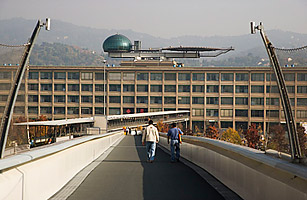
Lingotto, now a space for shops, hotels, a glass-orb conference center and a helipad
The closure of Torino's Lingotto assembly plant in 1982 was a body blow for the Italian car capital. The Fiat automobile factory, inaugurated in 1923, was once the largest in Europe. Assembly lines carried cars up five levels and delivered them fully formed onto the roof, where they'd whip around an oval test track before spiraling down the building's ramps and heading to showrooms. The shutdown marked the end of an era. That decade, Torino would lose more than 100,000 jobs, a trend that would continue through the rest of the century as the city's industrial dominance slowly bled away.
Today the Lingotto plant stands once again as the symbol of the city. Only now the old factory serves as a testimonial that there can be life after the auto industry. Redesigned in the 1990s by Italian architect Renzo Piano, it forms the hub of a revitalized commercial district. The assembly floors, far from silenced, host a shopping mall, a multiplex, two hotels and an art gallery, and on the roof are a rooftop meeting room, a panoramic restaurant and a helicopter landing pad. The test track remains, now at the disposal of hotel guests looking for a jog high above the city streets.
Torino — once known as the Detroit of Italy — has become a model of how a city can transform itself after an industrial collapse. It's the latest chapter in how this city, which dates to ancient Roman times, has remade itself as its political and economic fortunes have shifted. Once Italy's capital, Torino turned to industry at the end of the 19th century after power moved to Rome.
This time, when its home industry waned, Torino turned outward. An aggressive urban plan, expansion into international markets, investments in innovation and the buildup of new sectors like food and tourism have made the city one of the most dynamic in Italy. Roughly 60% of Torino's abandoned industrial land has been repurposed. Its per capita GDP is more than 10% higher than the national average. Delegations from hard-hit cities like Cleveland and Detroit come to learn how their metropolis might become the Torino of America. "Turin is a city that had a plan to come back," said Detroit Mayor Dave Bing while touring the city in November. "It's good to see we're not in this by ourselves."
Torino was a company town whose company nearly went down. When Fiat sneezed, Torino didn't just catch a cold; everybody competed to supply the handkerchief. So when the car company started to slump, much like GM, the city was suddenly faced with the possible loss of its only customer. Torino's leaders knew they had to diversify, not just technologically but also geographically. The city would concentrate on its core competences — automobiles, aerospace, industrial design — but market them elsewhere.
A series of public agencies began marketing Torino as a package. Rather than having a host of small companies feeding into a single big one, the businesses in the region would promote themselves as a single brand, offering one-stop shopping to clients all over the world. "It's strength through numbers," says Silvia Sabato, a manager at the Piemonte Agency for Investments, Export and Tourism, which markets the area's firms internationally. "We don't represent just one company but an ensemble of companies."
As an example, Sabato points to companies like the 2A die-casting foundry, located in a suburb about 20 minutes outside town. There, in the red glow of molten aluminum, the city's manufacturing tradition is still very much alive. Indeed, thanks to contracts developed through the agency that pull in more than a quarter of the company's $67 million annual turnover, the company logged its best year ever. "We will soon be expanding," says Vincenzo Ilotte, 2A's director. Exports account for 85% of the firm's business; Fiat, just 8%. "Fiat is one of our customers," says Ilotte. "It's not our only customer."